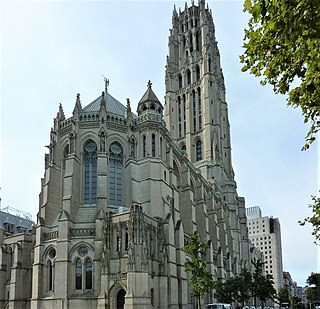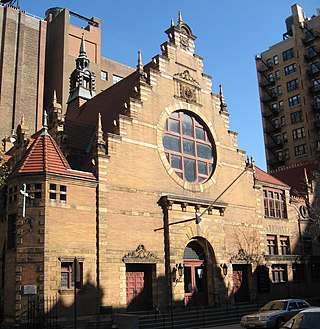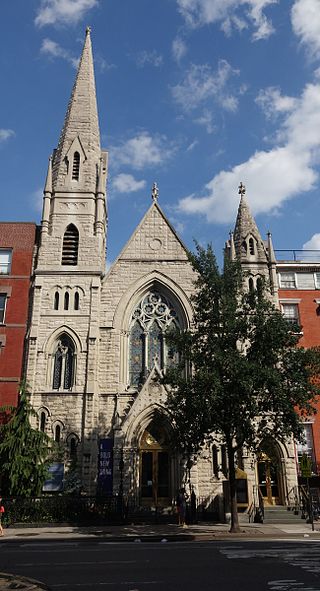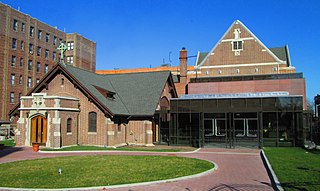
Rockefeller Center is a complex of 19 commercial buildings covering 22 acres (8.9 ha) between 48th Street and 51st Street in the Midtown Manhattan neighborhood of New York City. The 14 original Art Deco buildings, commissioned by the Rockefeller family, span the area between Fifth Avenue and Sixth Avenue, split by a large sunken square and a private street called Rockefeller Plaza. Later additions include 75 Rockefeller Plaza across 51st Street at the north end of Rockefeller Plaza, and four International Style buildings on the west side of Sixth Avenue.

Riverside Church is an interdenominational church in the Morningside Heights neighborhood of Manhattan in New York City, United States. The church is associated with the American Baptist Churches USA and the United Church of Christ. It was conceived by philanthropist businessman and Baptist John D. Rockefeller Jr. in conjunction with Baptist minister Harry Emerson Fosdick as a large, interdenominational church in Morningside Heights, which is surrounded by academic institutions.

The Marble Collegiate Church, founded in 1628, is one of the oldest continuous Protestant congregations in North America. The congregation, which is part of two denominations in the Reformed tradition—the United Church of Christ and the Reformed Church in America—is located at 272 Fifth Avenue at the corner of West 29th Street in the NoMad neighborhood of Manhattan in New York City. It was built in 1851–54 and was designed by Samuel A. Warner in Romanesque Revival style with Gothic trim. The façade is covered in Tuckahoe marble, for which the church, originally called the Fifth Avenue Church, was renamed in 1906.

The Interchurch Center is a 19-story limestone-clad office building located at 475 Riverside Drive and West 120th Street in Morningside Heights, Manhattan, New York City. It is the headquarters for the international humanitarian ministry Church World Service, and also houses a wide variety of church agencies and ecumenical and interfaith organizations as well as some nonprofit foundations and faith-related organizations, including the Religion Communicators Council. The National Council of Churches also occupied the building from its inception, but in February 2013, the NCC consolidated its offices on Capitol Hill in Washington, DC, and vacated its New York headquarters facilities. NCC's sister agency, Church World Service, remains a tenant in the building.

The West End Collegiate Church is a church on West End Avenue at 77th Street on Manhattan's Upper West Side. It is part of The Collegiate Reformed Protestant Dutch Church in the City of New York, the oldest Protestant church with a continuing organization in America. The Collegiate Church of New York is dually affiliated with the United Church of Christ (UCC) and the Reformed Church in America (RCA). The West End Collegiate Church is listed on the U.S. National Register of Historic Places.

Fifth Church of Christ, Scientist is a historic Classical Revival-style Christian Science church building located at 9 East 43rd Street near Madison Avenue and Grand Central Terminal in Manhattan, New York City. Built in 1921 on the previous site of St. Bartholomew's Episcopal Church, Fifth Church of Christ, Scientist, occupies part of the first two stories of a 21-story office building that was originally named the Canadian Pacific Building. The church auditorium seats 1800 people.

Church Missions House is a historic building at Park Avenue South and East 22nd Street in the Gramercy Park neighborhood of Manhattan in New York City. Part of an area once known as "Charity Row", the building was designed by Robert W. Gibson and Edward J. Neville Stent, with a steel structure and medieval-inspired facade. The design was inspired by the town halls of Haarlem and medieval Amsterdam. Church Missions House is so named because it was the headquarters of the Episcopal Church's Domestic and Foreign Missionary Society for much of the 20th century.

St. Ann’s Church was a Roman Catholic parish church at 110-120 East 12th Street between Fourth and Third Avenues in the East Village neighborhood of Manhattan, New York City. It was closed in 2003 and mostly demolished, except the front facade, in 2005. The site of the church is now occupied by a dorm of New York University.

The Collegiate Reformed Protestant Dutch Church is a Dutch Reformed congregation in Manhattan, New York City, which has had a variety of church buildings and now exists in the form of four component bodies: the Marble, Middle, West End and Fort Washington Collegiate Church, all part of the Reformed Protestant Dutch Churches of New York. The original congregation was established in 1628.

St. Nicholas Kirche is a former Roman Catholic church located at 127 East Second Street between Avenue A and First Avenue in the Alphabet City/East Village neighborhood of Manhattan, New York City. The church, known in German as Deutsche Römisch-Katholische St. Nicholas Kirche, was the national parish for the local German-speaking population.

The Isaac T. Hopper House is a Greek Revival townhouse at 110 Second Avenue between East 6th and 7th Streets in the East Village neighborhood of Manhattan, New York City. Located just south of the New Middle Collegiate Church, it was built in 1837 and 1838 as a rowhouse. The building was also known as the Ralph and Ann E. Van Wyck Mead House, after its first owner. 110 Second Avenue is the only remaining rowhouse out of a group of four at 106–112 Second Avenue that was used by the Meads' extended family, and was originally known as 108 Second Avenue.

The Middle Collegiate Church is a United Church of Christ church located at 112 Second Avenue between 6th and 7th Streets in the East Village neighborhood of Manhattan, New York City.

The Church of St. Stanislaus Bishop & Martyr is home to the oldest Polish Roman Catholic parish in the Roman Catholic Archdiocese of New York, It is located at 101 East 7th Street between First Avenue and Avenue A in the East Village neighborhood of Manhattan, New York City.

The Brick Presbyterian Church is a large congregation at Park Avenue and 91st Street on the Upper East Side of Manhattan in New York City. A congregation of the Presbyterian Church (U.S.A.), it is known for its Day School and music programs. It was founded as an offshoot of First Presbyterian Church. Its first building, in Lower Manhattan, opened in 1768. The Park Avenue location opened April 14, 1940.

Fort Washington Collegiate Church is a Collegiate Reformed Protestant Dutch Church located at Magaw Place and 181st Street in the Washington Heights neighborhood of Manhattan, New York City.

The construction of the Rockefeller Center complex in Midtown Manhattan, New York City, was conceived in the late 1920s and led by John D. Rockefeller Jr.. Rockefeller Center is on one of Columbia University's former campuses and is bounded by Fifth Avenue to the east, Sixth Avenue to the west, 48th Street to the south, and 51st Street to the north. The center occupies 22 acres (8.9 ha) in total, with some 17 million square feet of office space.

Holyrood Episcopal Church is a Protestant Episcopal Church located at 715 West 179th Street in the Washington Heights neighborhood in upper Manhattan, New York City.
Dutch people have had a continuous presence in New York City for nearly 400 years, being the earliest European settlers. New York City traces its origins to a trading post founded on the southern tip of Manhattan Island by colonists from the Dutch Republic in 1624. The settlement was named New Amsterdam in 1626 and was chartered as a city in 1653. Because of the history of Dutch colonization, Dutch culture, politics, law, architecture, and language played a formative role in the shaping of New York City culture. The Dutch were the majority in New York City until the early 1700s, and the Dutch language was commonly spoken until the mid to late-1700s.

689 Fifth Avenue is a commercial building in the Midtown Manhattan neighborhood of New York City, at the northeast corner of Fifth Avenue and 54th Street. The building was designed by Warren and Wetmore and constructed from 1925 to 1927.


















